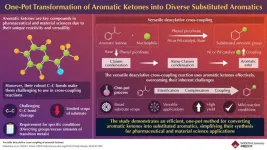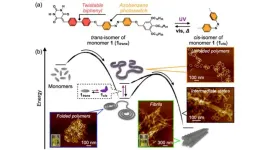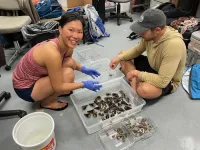(Press-News.org)
Aromatic ketones have long been valuable intermediates in chemical synthesis, particularly in cross-coupling reactions where different chemical entities are combined to form new compounds. For instance, a process called deacylative cross-coupling removes the acyl group from the aromatic ketone, allowing it to bond with other chemicals and produce a wide variety of useful compounds. These reactions are crucial for producing a wide array of aromatic compounds used in various industries like agrochemicals.
However, the utility of aromatic ketones has been limited due to the difficulty in breaking their strong carbon-carbon bonds. These robust bonds are challenging to cleave, often requiring specific conditions or catalysts. Traditional methods for overcoming this challenge have involved complex and costly procedures, which include the use of directing groups and large amounts of transition metals. These limitations can complicate the process and increase overall costs, hindering the broader application of aromatic ketones in various industrial and synthetic contexts.
To address traditional challenges in using aromatic ketones, a team of researchers led by Professor Junichiro Yamaguchi from the Faculty of Science and Engineering, School of Advanced Science and Engineering at Waseda University has developed a groundbreaking one-pot method that optimizes the conversion of aromatic ketones into aromatic esters. The research, published in Chem on 12 September 2024, highlights its potential for broader use in synthetic chemistry.
This new approach significantly simplifies the reaction process by integrating a Claisen reaction and a retro-Claisen reaction into a single step. The Claisen reaction combines two molecules to form a larger intermediate compound, while the retro-Claisen reaction modifies this intermediate to produce the desired ester. By combining these steps into a one-pot process, the researchers have managed to simplify the synthesis, reduce reaction times, and minimize the need for additional purification steps. "This advancement enhances the versatility and utility of aromatic ketones, facilitating their use in pharmaceutical synthesis and materials science," remarks Dr. Yamaguchi.
The flexibility of the new reaction method allows it to work with a wide variety of reactants, including alcohols, phenols, amines, and thiols. This technique is particularly notable because it enables seven different types of chemical transformations turning compounds into thioethers, aryl groups, hydrogen, α-aryls, methylphosphonyl groups, amines, and ethers. This broad range of capabilities makes the method highly adaptable and useful for various chemical processes, improving how aromatic ketones can be used across different industries.
Furthermore, the catalyst system employed in this reaction has shown notable stability and reusability, making the process scalable for industrial applications. “This reaction represents the first successful example of directly catalyzing aromatic ketones without the use of directing groups, setting the stage for future advancements in synthetic chemistry,” explains Dr. Yamaguchi.
This groundbreaking approach represents a significant leap forward in synthetic chemistry, offering a more streamlined, cost-effective, and multifaceted method for utilizing aromatic ketones. As the method continues to be explored and refined, it promises to play a crucial role in advancing the field of synthetic chemistry and beyond.
***
Reference
Authors: Hikaru Nakahara1, Ryota Isshiki1, Masayuki Kubo1, Keiichiro Iizumi1, Kei Muto2, and Junichiro Yamaguchi1
Title of original paper: Versatile deacylative cross-coupling of aromatic ketones
Journal: Chem
DOI: https://doi.org/10.1016/j.chempr.2024.07.002
Affiliations
1Department of Applied Chemistry, Waseda University
2Waseda Institute for Advanced Study, Waseda University
About Waseda University
Located in the heart of Tokyo, Waseda University is a leading private research university that has long been dedicated to academic excellence, innovative research, and civic engagement at both the local and global levels since 1882. The University has produced many changemakers in its history, including nine prime ministers and many leaders in business, science and technology, literature, sports, and film. Waseda has strong collaborations with overseas research institutions and is committed to advancing cutting-edge research and developing leaders who can contribute to the resolution of complex, global social issues. The University has set a target of achieving a zero-carbon campus by 2032, in line with the Sustainable Development Goals (SDGs) adopted by the United Nations in 2015.
To learn more about Waseda University, visit https://www.waseda.jp/top/en
About Professor Junichiro Yamaguchi
Junichiro Yamaguchi is a Professor at the Faculty of Science and Engineering at Waseda University. He earned his Ph.D. from Tokyo University of Science in 2007 and gained postdoctoral experience at The Scripps Research Institute. Dr. Yamaguchi began his academic career at Nagoya University as an assistant professor before joining Waseda University in 2016, where he was promoted to full professor in 2018. His research focuses on chemistry with a special interest in making complex topics engaging for students. He also leads the Chem-Station chemistry portal site.
END
In polymers, the competition between the folding and aggregation of chains, both at an individual level and between chains, can determine the mechanical, thermal, and conductive properties of such materials. Understanding the interplay of folding and aggregation presents a significant opportunity for the development and discovery of polymeric materials with tailored properties and functionalities.
This also holds true for non-covalent counterparts of conventional covalent polymers, i.e., supramolecular polymers (SPs). SPs are expected to have practical applications as novel stimuli-responsive ...
MINNEAPOLIS / ST. PAUL (08/20/2024) — A first-of-its-kind adaptive 3D printing system developed by University of Minnesota Twin Cities researchers can identify the positions of randomly distributed organisms and safely move them to specific locations for assembly. This autonomous technology will save researchers time and money in bioimaging, cybernetics, cryopreservation, and devices that integrate living organisms.
The research is published in Advanced Science, a peer-reviewed scientific journal. The researchers ...
WASHINGTON (August 20, 2024) – Much of the early human fossil record originates from just a few places in Africa, where favorable geological conditions have preserved a trove of fossils used by scientists to reconstruct the story of human evolution. One of these fossil hotspots is the eastern branch of the East African Rift System, home to important fossil sites such as Oldupai Gorge in Tanzania. Yet, the eastern branch of the rift system only accounts for 1% of the surface area of Africa—a fact that makes it possible to estimate how much information scientists who rely on such small samples are missing.
In ...
DENVER, Aug. 20, 2024 — Who are we? Why are we here? As the Crosby, Stills, Nash & Young song suggests, we are stardust, the result of chemistry occurring throughout vast clouds of interstellar gas and dust. To better understand how that chemistry could create prebiotic molecules — the seeds of life on Earth and possibly elsewhere — researchers investigated the role of low-energy electrons created as cosmic radiation traverses through ice particles. Their findings may also inform medical and environmental applications on our home planet.
Undergraduate student Kennedy Barnes will present the team’s results at the fall meeting of the American ...
Scientists are finding clues for how to treat diabetes and hormone disorders in an unexpected place: a toxin from one of the most venomous animals on the planet.
A multinational research team led by University of Utah scientists has identified a component within the venom of a deadly marine cone snail, the geography cone, that mimics a human hormone called somatostatin, which regulates the levels of blood sugar and various hormones in the body. The hormone-like toxin’s specific, long-lasting effects, which help the snail hunt its prey, could also help scientists design better ...
We know that the Earth has an iron core surrounded by a mantle of silicate bedrock and water (oceans) on its surface. Science has used this simple planet model until today for investigating exoplanets – planets that orbit another star outside our solar system. “It is only in recent years that we have begun to realise that planets are more complex than we had thought,” says Caroline Dorn, Professor for Exoplanets at ETH Zurich.
Most of the exoplanets known today are located close to ...
Platelets are circulating cell fragments known to clump up and form blood clots that stop bleeding in injured vessels. Cardiologists have long known that platelets can become “hyperreactive” to cause abnormal clotting that blocks arteries and contributes to heart attack, stroke, and poor blood flow (peripheral artery disease) in the legs of millions of Americans.
Despite this major contribution to cardiovascular risk, routine measurement of whether each patient’s platelets clump (aggregate) too much has been infeasible to date. ...
Can research on diseases as diverse as, for example, diabetes, cardiovascular diseases, psychiatric disorders and endometriosis be linked? The answer is yes if the research focuses on collecting and analysing large amounts of data from both Danish and international registers and biobanks to learn more about, among other things, risk factors, relationships, patterns, treatment and consequences.
And this is exactly what a new international Pioneer Centre, The Pioneer Centre for SMARTbiomed (Statistical and Computational Methods for Advanced Research ...
A multidisciplinary team of scientists led by Carlo Ballatore, Ph.D., at University of California San Diego and Kurt Brunden, Ph.D., at the University of Pennsylvania has been awarded a $6.9 million grant from the National Institute on Aging (NIA) to prepare a potential disease-modifying Alzheimer’s treatment for future clinical trials. In a recently published study about the new compound, called CNDR-51997, the team found it was effective in restoring brain health in mouse models of Alzheimer's disease. CNDR-51997 was identified through a joint drug discovery program at Penn and UC San Diego that was supported by grants from the NIA.
The ...
Atherosclerosis, a major cause of mortality worldwide, involves an overgrowth of vascular smooth muscle cells in the blood vessels, constraining blood flow and potentially causing cardiovascular diseases. Against this backdrop, researchers from Shinshu University recently developed a DNA aptamer called iSN04 that targets and counteracts with the protein nucleolin in smooth muscle cells. This anti-nucleolin aptamer helps maintain smooth muscle cells in a differentiated state, offering new treatment potential for atherosclerosis and other vascular ...








